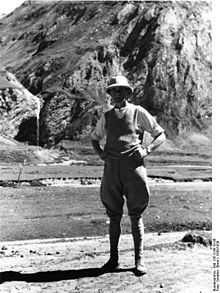Basil Gould


Sir Basil John Gould, CMG, CIE (1883–1956) was a British Political Officer in Sikkim, Bhutan and Tibet from 1935 to 1945.
Gould was known by the nickname "B.J.", and went to school at Winchester College and Oxford University. He joined the Indian Civil Service in 1907.[1]
Gould was a British Trade Agent in Gyantse, Tibet from 1912 to 1913.[2][3] In 1912, the Dalai Lama asked that some "energetic and clever sons of respectable families" should be given "world-class educations at Oxford College, London". The Indian government decided that Gould, who was about to go on leave back to England, should guide the four young boys (known as the "Four Rugby Boys") on their journey to the United Kingdom and assist them during their first few weeks in England in April 1913.[4]
Gould married Lorraine Macdonald (1898–1935) when back in England on leave from India on September 14, 1921. They had two sons.[5]
In 1926 Gould was posted to the British Legation in Kabul, Afghanistan. He was subsequently assigned to Kurrum, Malakand and Waziristan and finally in 1933 to Baluchistan. His wife Lorraine died in Baluchistan in 1935.[5]
In August 1936, Gould led a delegation to Lhasa to negotiate with the Tibetan government on the possibility of the 9th Panchen Lama's return to Tibet. Gould also discussed British military aid to Lhasa. Gould inquired about the creation of a British office in Lhasa, but the Tibetan government rejected this. Gould eventually departed Lhasa, but left behind his commercial representative, Hugh Richardson, who had been previously stationed in Gyantse. Richardson was equipped with a radio so Richardson could maintain contact with the British.[6]
Gould married his second wife Cecily, the daughter of Colonel C. H. Brent-Good, of Yarmouth on the Isle of Wight. Gould had one son with Cecily.[1]
In 1940, Gould attended the installation ceremonies of the 14th Dalai Lama in Lhasa, Tibet.[7] Gould brought a gift of a Meccano set for the young Tenzin Gyatso.[8] In 1941, Gould was knighted by King George VI and received the title of "Sir". In 1945, the British Mission under Gould helped to start a school in Lhasa, but it was soon closed under pressure from Tibetan religious authorities.[9]
Publications
- The jewel in the lotus: Recollections of an Indian political, Basil John Gould, Chatto & Windus, 1957.
- Tibetan language records, Basil Gould, Tharchin, 1949
- Tibetan Word Book, Sir Basil Gould, C.M.G., C.I.E., and Hugh Edward Richardson, Oxford University Press, 1943
- Report on the Discovery, Recognition and Installation of the Fourteenth Dalai Lama, B. J. Gould, New Delhi, 1941.
- The Discovery of the Fourteenth Dalai Lama, B. J. Gould, The Geographical Magazine, volume 19, October 1946, p. 246-258.
References
- ↑ 1.0 1.1 Obituary: Sir Basil Gould, C. M. G., C. I. E., F. M. Bailey, The Geographical Journal, Vol. 123, No. 2 (Jun., 1957), pp. 280-281.
- ↑ Gould also visited Tibet in 1936, 1940 and 1941.
- ↑ Tibetan Histories: A Bibliography of Tibetan-Language Historical Works, Dan Martin, with contributor Michael Aris, Serindia Publications, 1997, ISBN 0-906026-43-1
- ↑ The History of Tibet, Alex Mackay, Routledge, 2003, ISBN 0-7007-1508-8
- ↑ 5.0 5.1 Lorraine Gould Collection, Lorraine Macdonald Gould, Reference code: GB165-0407, Dates of creation of material: 19-25 Dec 1928, Middle East Centre, St Antony's College, Oxford.
- ↑ (8) The Demise of the 13th Dalai Lama and Huang Musong's Entry Into Tibet, Wang Jiawei and Nyima Gyaincain, Chapter VI: Tibet is Not an Independent Political Entity During the Period of the Republic of China, in The Historical Status of China's Tibet, China Intercontinental Press, 1997.
- ↑ Seeing Lhasa: British Depictions of the Tibetan Capital, 1936-1947, Clare Harris, Tsering Shakya, Serindia Publications, 2003.
- ↑ Kundun: A Biography of the Family of the Dalai Lama, Mary Craig, Counterpoint Press, 1998, ISBN 1-887178-91-0
- ↑ Tibet and the United States of America: An Annotated Chronology of Relations Since 1900, Ken Herold.
|